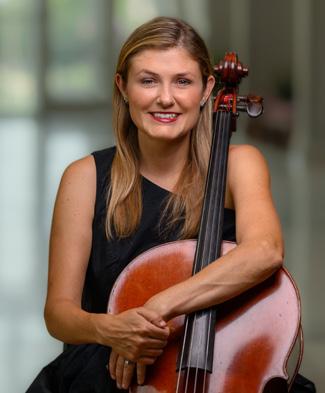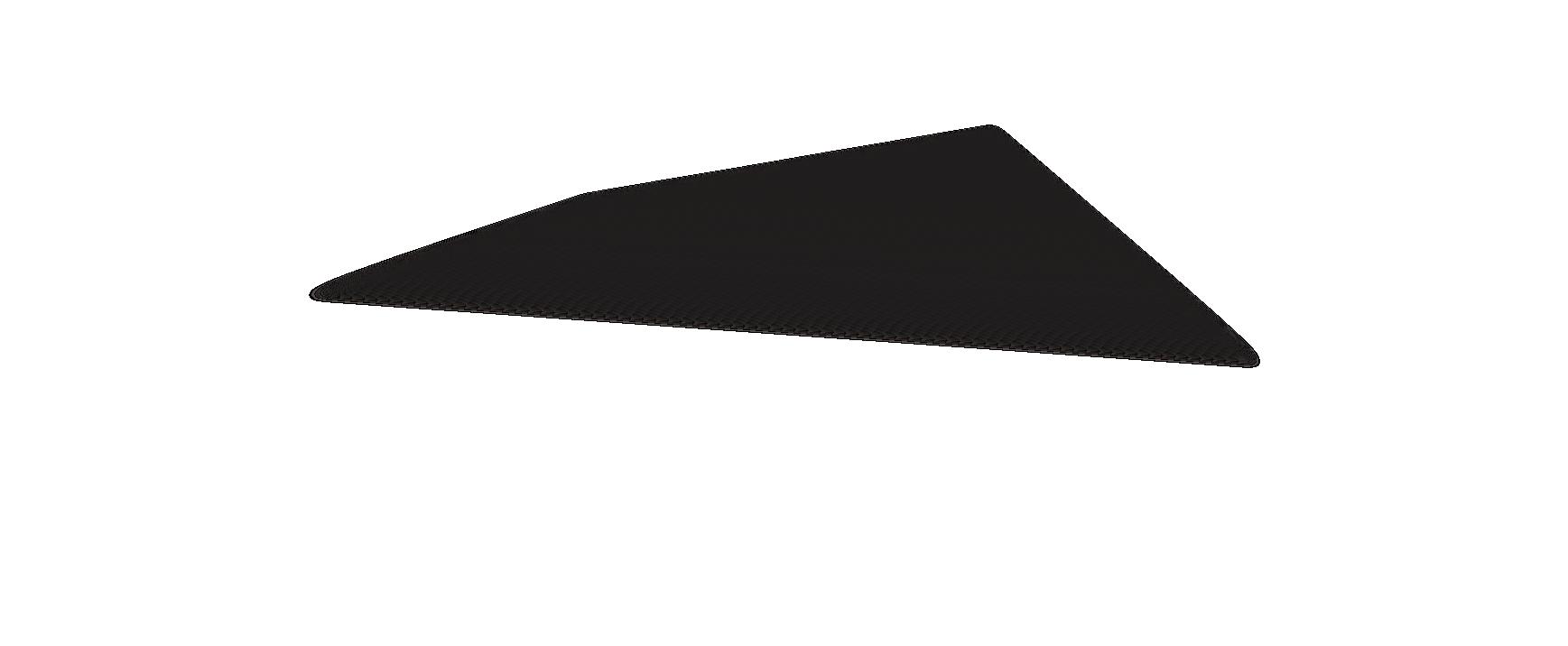PROGRAM NOTES
Suite for String Orchestra
Libby Croad
Strati, Italian for “layers,” is the word that is central to each movement of Suite for String Orchestra by Libby Croad. Across all its movements, Croad employs the idea of layering— whether through staggered entrances, overlapping melodic fragments, or evolving harmonic textures—to create a work that continuously shifts and unfolds in dynamic ways. This technique not only gives the piece a sense of organic growth but also allows for rich interplay between individual voices within the ensemble.
The first movement, Strati, is centered around the concept of melodic layering. From the very beginning, each instrument enters one at a time with its own distinct melodic motive, gradually building a rich and interwoven texture. In a refreshingly unconventional approach, the viola takes on a central role in this movement, introducing key melodies that are then passed throughout the ensemble. This gives the movement a distinctive character and highlights the often-understated expressive power of the viola.
The second movement, Élégie, features CSU’s cello professor, Dr. Meredith Blecha-Wells, in a poignant and expressive solo role. This movement exemplifies harmonic layering, with multiple harmonies stacked upon one another in a way that creates a sense of tonal ambiguity. Rather than settling into a traditional harmonic framework, the movement drifts through shifting sonorities, allowing harmonies to blend and collide unpredictably. This ambiguity heightens the elegiac character of the piece, evoking a sense of searching, tension, and unresolved emotion. The interplay between the solo cello and the ensemble enhances this effect, as the melody weaves through the harmonic textures, at times grounding the listener and at others adding to the movement’s elusive, ever-shifting atmosphere.
The third movement, Moto Perpetuo, showcases rhythmic layering, with driving, interlocking patterns that create a sense of relentless motion. True to its name, meaning “perpetual motion,” the movement pulses forward with constant energy, as different rhythmic motifs overlap and interact. This layering of rhythmic ideas generates both momentum and complexity, making the movement feel both propulsive and intricate.
Libby Croad is a British composer and violist whose works often highlight the expressive potential of string instruments. Her compositions blend classical tradition with modern harmonic language and intricate textures, making her music both engaging and innovative. Suite for String Orchestra exemplifies her ability to craft compelling musical narratives, using the concept of layering not just as a compositional technique but as the foundation of the suite’s entire musical architecture.
Hiraeth
Dave Dexter (b. 1985)
“Hiraeth” is a Welsh word for homesickness - not only for a home you’ve left, but a home you cannot return to or never existed at all. Having moved house shortly before I began composing the work, and being prone to crippling nostalgia for places not just months but decades in my past, this concept of extreme homesickness immediately caught my attention. Thus Hiraeth became a tone poem for my old homes and haunts, trees and rivers - places I’ve walked and never will again.
Compositionally, Hiraeth is centred round a five-note theme first established (0.45) after the work’s ominous, divided low strings opening. At first played without harmonic support, bass and cello divisi are introduced before the theme’s darker four-note variant is introduced (1.12), both joining for the piece’s crescendo (4.38). A second, more romantic and mournful theme acts as a counter to the bitter triumph of the first, played initially by violas and cellos (1.52) and returned to later with double bass, cello and finally unison violin octaves (3.46). The piece closes as it opens, ending with a flourishing if slightly dissonant swell.
A highly tonal piece, the orchestration is appropriately traditional - themes often played in unison across octaves between either cellos and violas, or violins I & II, with the other sections providing harmonic support. To achieve the wide, lush sound I love in string music, these supporting sections are generally divided; tremolo is often used for texture in quieter moments, and themes are passed between sections to be explored and evolved.
— Program Notes by Dave
Dexter
Molly on the Shore
As noted by Sandra Dackow, Percy Grainger’s Molly on the Shore is a lively and vibrant setting of two traditional Irish reels, Temple Hill and Molly on the Shore. Originally composed in 1907 as a birthday gift for his mother, Grainger first wrote the piece for string quartet before arranging it for wind band, full orchestra, and various other ensembles. This version for string orchestra preserves the original’s rhythmic vitality and intricate textures while showcasing the expressive and virtuosic capabilities of the string ensemble.
True to form, Grainger’s inventive orchestration choices shine in this adaptation. The violas—yet again!—introduce the piece’s main melody, setting the energetic tone that carries throughout. The piece is constantly in motion, with interlocking lines and rhythmic layering that propel the music forward. Grainger’s signature use of folk material is not just a straightforward setting but a dynamic reinterpretation, full of counterpoint, sudden dynamic contrasts, and colorful harmonic shifts. This string orchestra adaptation by Sandra Dackow
Percy Grainger, arr. Sandra Dackow
allows the piece’s lively dance-like character to shine through, making it a thrilling and engaging work for both performers and audiences.
— Program Notes by Sam Cooper
Some years ago, the YouTube algorithm saw fit to feed me an unusual piece featuring two violins, a hardanger fiddle, and a nyckelharpa (a bowed Swedish string instrument). It was striking - beautiful, ethereal, and haunting, and showcased a compelling array of string techniques. Much to my surprise, the piece was called ‘Cumberland Gap’; it sounded nothing like the cheery, nostalgic old-time ‘Cumberland Gap’ I knew, which when played with words envisions reuniting with one’s grandparents and farming sweet potatoes. I immediately learned the new tune, and despite my best efforts to focus on my dissertation, could not rid myself of the desire to arrange it for string orchestra. I contacted one of the violinists, Brittany Haas, for permission to perform it and for some information on the piece - namely why it was called ‘Cumberland Gap’, of all things. She wasn’t sure, but said it sounded something like Casey Driessen’s piece ‘Gaptooth’. It’s from this I derived part of my arrangement’s name, ‘Cumberteeth’. Listen also for a new melody and a brief switch to a major tonality in the middle of the piece, my homage to the traditional old-time ‘Cumberland Gap’.
— Program Notes C.S. Lee
Capriol Suite
Peter Warlock (1894 – 1930)
Peter Warlock’s Capriol Suite features Renaissance-inspired dances with a 20th century twist. Warlock composed the six-movement suite in October 1926. It is dedicated to the French composer and music critic Paul Ladmirault, and includes six movements based on the Renaissance dance manual, Orchésographie by Thoinot Arbeau. Those movements include the Basse-Danse (or “low dance” referencing its slow, stately steps close to the ground); Pavane (slow, duple meter dance thought to have originated in Padua); Tordoin (lively, triple meter dance derived from the French tordre or “to twist”); Bransles (French dance meaning to shake or wobble); Pieds-en-l’air (translating literally to “feet in the air”, a floating dance); and Mattachins (or sword dance). This afternoon we perform the first, second, fifth, and sixth of these movements.
While each movement evokes the metric stress of its namesake, Warlock encases them in a harmonic language that is uniquely his own. Mattachins, for example, finishes with crunchy dissonance and rhythmic complexity, ending the suite with bizarre finality. Taken together, the suite’s dramatic textual and dynamic contrasts serve its title Capriol (meaning a “playful leap”) well. In fact, the composition mirrors Warlock’s intriguing and playful personality. Originally born Philip Arnold Heseltine, Warlock adopted the pseudonym Peter Warlock after developing an interest in the occult, witchcraft, and wizardry. He was proud of his Welsh
heritage and sought to integrate his love for Celtic culture and Elizabethan music with his reverence for English composer Frederick Delius.
The version we perform this afternoon is for string orchestra. It was originally composed for piano duet. A full orchestra version also exists.
— Program Notes by Rachel Waddell
The CSU Concert Orchestra wishes to thank:
Margaret Miller
Meredith Blech-Wells
Mike Solo
Valerie Reed, Peter Muller, and their Team
Jennifer Clary
Nicole Darling
Jim Doser
Ethan Urtz
Devon Bignell
Cora Larson
Sam Cooper
COLORADO STATE UNIVERSITY MUSIC APPLIED FACULTY
Violin
Ron Francois
Viola
Margaret Miller
Cello
Meredith Blecha-Wells
Bass
Forest Greenough
Guitar
Jeff Laquatra
Flute
Ysmael Reyes
Michelle Stanley
Oboe
Galit Kaunitz
Clarinet
Wesley Ferreira
Saxophone
Peter Sommer
Dan Goble
Bassoon
Cayla Bellamy
Trumpet
Stanley Curtis Horn
John McGuire
Trombone
Drew Leslie
Tuba/Euphonium
Chris Bloom
Percussion
Eric Hollenbeck
Shilo Stroman
Harp
Kathryn Harms
Piano
Bryan Wallick
Tim Burns
Organ
Joel Bacon
Voice
Nicole Asel
Tiffany Blake
John Lindsey
Meredith Blecha-Wells
Praised for her “beautifully full and lyrically strong tone” by Gramophone Magazine, Meredith Blecha-Wells is a sought-after performer and instructor. She has played throughout much of the United States, as well as Europe, Australia, South America, and Asia. Currently based in Colorado, Dr. Blecha-Wells recently joined the faculty at Colorado State University.
As a recording artist, Dr. Blecha-Wells has released several CDs spanning the solo, chamber music, and orchestral space. Her solo album was described as “technically dazzling” (the Whole Note) and she was praised for her “lyrical warmth and her powerful athleticism” (Classical Music Discoveries). Dr. Blecha-Wells’ recordings can be found on labels including Naxos, Navona, and Onyx Lane Productions and broadcast on numerous radio stations such as WFMT (Chicago, IL), WMBR (Cambridge, MA), KALX (Berkley, CA), WRUV (Burlington, VT), WCNY (Syracuse, NY), KUCO (Edmond, OK), among others.
Dr. Blecha-Wells previously served as the Professor of Cello at Oklahoma State University where she was awarded the College of Arts and Sciences Junior Faculty Award for Scholarly Excellence as well as the First Lady of OSU Distinguished Music Professor award. A passionate pedagogue, Dr. Blecha-Wells is committed to raising the efficiency and joy in learning. Her students have gone on to remarkable programs including the Juilliard School, the New England Conservatory, the Eastman School of Music, Rice University, the University of Michigan, the Manhattan School of Music, the San Francisco Conservatory, Northwestern University, Indiana University, the Cleveland Institute of Music, the Oberlin Conservatory of Music, the University of Southern California, DePaul University, and the Cincinnati Conservatory of Music. Additionally, her students have won several competitions including the YoungArts National Awards, the Classics Alive Artists, Enkor International Competition, American Protégé Competition, Ad Astra String Competition, MTNA, Hyechka String Competition, among others. Dr. Blecha-Wells’ students have also been selected to participate in prestigious festivals including the National Youth Orchestra and the National Youth Orchestra 2, Brevard Music Festival, Eastern Music Festival, Green Mountain Music Festival, and several others.
Dr. Blecha-Wells has taught at numerous festivals, clinics, and institutes spanning six continents. She has had the pleasure of teaching at the International Cello Institute, the Alaska
Cello Intensive, Gran Encuentro Chelistas in Colombia, the Saarburg Chamber Music Festival in Germany, the Chicago Suzuki Institute, the Austin Suzuki Institute, among others. She has given numerous clinics and was the featured cello clinician at the 2024 American String Teachers Association Conference.
Dr. Blecha-Wells received a bachelor’s and master’s degree in Cello Performance from Indiana University and holds a Doctor of Musical Arts in Performance and Literature from the Eastman School of Music. Her teachers have included Janos Starker, Alan Harris, Emilio Colon, Helga Winold, Richard Hirschl, and Marc Johnson. Additional studies include festival participation at the Taos School of Music, the Norfolk Chamber Music Festival, Spoleto Festival USA, the National Repertory Orchestra, and the Bowdoin International Music Festival.
Peter Muller
Peter holds a degree in music education and taught for 20 years before leaving the profession to open the Candlelight Dinner Playhouse in Johnstown. Peter has conducted, directed, or designed well over 100 productions for Colorado audiences including shows at the Denver Center Theatre Company, Colorado State University, Greeley Philharmonic Orchestra, Front Range Music Theatre, Candlelight Dinner Playhouse, Nonesuch Theater, Carousel Dinner Theatre, OpenStage Theatre, Longmont Theatre Company, Fort Collins Children’s Theatre, Loveland Opera Theatre, and the Greeley Stampede Troupe. In 1990, Peter received a special commendation from Governor Roy Romer for his “contribution to the culture of Colorado” for his work as music director and conductor for the Colorado Theatre Orchestra. More recently, Peter received a Broadway Denver Award nomination for Best Musical Director for his production of Shrek, The Musical and won the award for The Hunchback of Notre Dame. Peter will be conducting a production of Fiddler on the Roof next summer.

Sam Cooper
Sam Cooper is currently pursuing his master’s in instrumental conducting at Colorado State University under the mentorship of Dr. Rachel L. Waddell. He serves as the Assistant Conductor of Orchestras at CSU and the Assistant Conductor for the Health and Wellness Community Orchestra, a Fort Collins-based ensemble that fosters a welcoming and engaging environment where musicians of all backgrounds can enjoy playing together.
Sam studied violin with Dr. Philip Ficsor and Dr. Emily Ondracek-Peterson at MSU Denver, where he earned degrees in music performance and music education in December 2023. He has played violin with various musical groups, including the Aurora Symphony and Empire Lyric Players, and held the roles of concertmaster and assistant conductor with the MSU Denver Symphony Orchestra under the direction of Dr. Brandon Stephen Matthews. As a co-founder and violinist of the Apollo String Quartet, Sam remains actively engaged in chamber music.
In January 2025, he was selected to participate in a conducting workshop with Carl Topilow and the Cleveland Pops Orchestra. He looks forward to participating in another conducting workshop in June 2025 with Diane Wittry and Silas Huff in New York City. Sam encourages you to follow his conducting journey on Instagram: @cooper_conducts
Rachel Waddell
With energy, imagination, and a passion for people, American conductor Rachel Waddell proves an unabashed advocate for the 21st century orchestra. Her leadership across the country demonstrates her innate ability to transform vision into action. Rachel believes by uplifting, celebrating, and reflecting the artistry of our neighbors, orchestras become the creative heartbeat of our communities. Through breathtaking collaborations and an untiring dedication to education, mentorship, and community, Rachel inspires transformative experiences and ensembles.
Rachel serves as the Director of Orchestras at Colorado State University. Rachel’s contributions to music education were recognized in 2024, when she was named a quarterfinalist for the 2025 Music Educator Award through the GRAMMYs. She is a popular clinician and guest conductor throughout the country. She conducted the Texas Music Educators Association All State Sinfonietta Orchestra in 2025, and the AA Montana Festival Orchestra in Helena in 2024. Previously she was the Director of Orchestral Activities and Assistant Professor with the Arthur Satz Department of Music at the University of Rochester in New York. The UR Orchestras gained recognition as a two-time national winner for the American Prize’s Vytautas Marijosius Memorial Award in Orchestral Programming in 2019 and 2020. In 2021, they won international acclaim in collaboration with conductor Tiffany Chang and Oberlin Conservatory through a digital performance of Beethoven’s Choral Fantasy, named Best Instrumental Performance of 2021 by the LIT Talent Awards.
Rachel maintains a busy profile in the professional and academic worlds. She has conducted orchestras around the world including the Orchestre Métropolitain, the Rochester, Las Vegas, Fort Wayne, and Denver Philharmonics, the Greater Bridgeport Symphony, the Southwest Michigan Symphony Orchestra, and Cleveland’s Suburban Symphony. While serving as the Associate Conductor of the Canton Symphony Orchestra in Ohio, Rachel conducted over 80 performances of classical, pops, and education concerts. She has attended numerous conducting programs including the Dallas Opera’s prestigious Hart Institute for Women Conductors, and Mark Shapiro’s Conducting Intensive at Juilliard. In August 2022 she made her Vienna debut conducting Così fan tutte as part of the Vienna Opera Academy. In July 2023 she made her Canadian debut with the Orchestre Métropolitain, after being selected to conduct by Yannick Nézet-Séguin at Le Domaine Forget de Charlevoix.
Rachel’s interest in the constantly evolving role and responsibility of orchestras within their communities led her to co-found Conductors for Change, Inc., a 501(c)(3) for anyone reimagining the future of the American orchestra.
Rachel holds a DMA in Orchestra Conducting from the University of Nevada, Las Vegas, and a certificate in Music Industry Essentials from the prestigious Clive Davis Institute of Recorded Music at NYU’s Tisch School of the Arts.
To learn more about Rachel Waddell please visit www.rachelwaddellconductor.com or follow her on Instagram @rachel_waddell_conductor .











